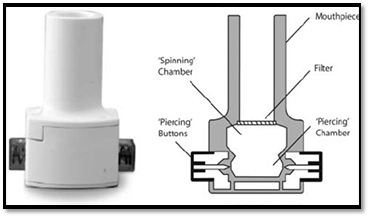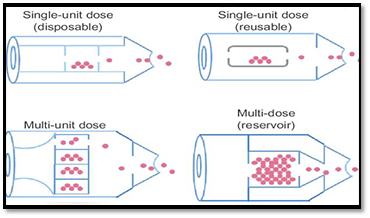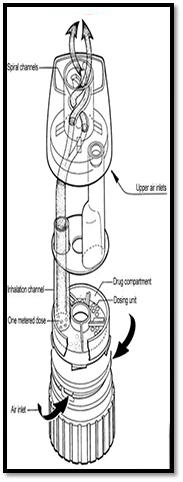
Finding 'Sanjivani', Daily! (Part-5)
Blog Space / Finding 'Sanjivani', Daily! (Part-5)

- The Motherhood Factor
- The “Higher" Connection
- Man proposes, God disposes
- From Pessimism To Optimism
- Finding 'Sanjivani', Daily! (Part-7)
- Finding 'Sanjivani', Daily! (Part-6)
- Finding 'Sanjivani', Daily! (Part-5)
- Finding 'Sanjivani', Daily! (Part-4)
- Finding 'Sanjivani', Daily! (Part-3)
- Interesting case of pneumonia
- Finding 'Sanjivani', Daily! (Part-2)
- On the moment of 100th Pulmonology Teleconsultation
- Finding 'Sanjivani', Daily
- Why so "Breathless"?
- A Blessing in Disguise
- The Art of Taking Consent
- The Oldman's Pursuit
No. This blog is not about any miracle drug or vaccine against SARS Co-V2 virus responsible for the current deadly pandemic of COVID19. This is regarding the class of medications already invented & used by millions of people across the globe daily - by force or by choice. They are inhaler medications or as commonly called "Pump".
The quest to develop ' propellant free ' inhaler remained one of the major driving force to invent an alternative of pressurized Metered-Dose Inhalers (pMDI), as warranted by the Montreal protocol in 1980s – limiting use of Chlorofluorocarbon (CFC) as propellant in pMDIs owing to the significant environmental dangers posed by it. Though, the first Dry Powder Inhaler (DPI) was launched in 1940s, to deliver penicillin, various DPI devices evolved after 1960s for primary use in airway diseases and come up with different designs after 1980s.
Unlike conventional pMDIs, DPI deliver drug only when it is inhaled (breathe actuated). Hence, the drug delivery is chiefly dependent on :
A) Inspiratory flow generated by the patient.
B) The technical characteristic, turbulence and resistance produced inside the device.
The capsule based DPI technology relies on powder mixture of ‘micronized' drug particles with aerodynamic diameter of 1-5 microns (essential for lung deposition) blended with excipient 'carrier' particles like lactose with principal adhesive forces, including van der Waals forces, electrostatic forces and the surface tension of adsorbed liquid layers. Environmental factors, especially temperature and humidity, are key factors that can impact DPI formulation stability and performance. The impact of later making the blend more cohesive and therefore more difficult to disperse. Hence, it has to be stressed upon to inhale forcefully and deeply, particularly in the initial phase of inspiration while using DPI.
In figure below: single unit dose capsule based DPI device

The advantage of breath actuated drug delivery becomes the disadvantage as small kids and patients with advanced respiratory diseases cannot produce sufficient inspiratory flow to disperse/de-aggregate/de-agglomerate micronized drug & carrier particles leading to poor lung deposition. Also, inertial impaction becomes the predominant mode of drug delivery resulting in reduced drug deposition in peripheral airways.
Today, mainly three types of DPIs are available:
Single unit dose : A single hard gelatin capsule containing formulation (drug + carrier) has to be loaded each time in capsule chamber.
Multiple dose, reservoir : bulk amount of drug (usually without carrier) is contained in storage unit with in-built mechanism to deliver single metered dose with each actuation.
Multiple unit-dose : individual doses are delivered from pre-metered blisters/discs containing drug and carrier with each actuation.

The above mentioned devices can be further classified according to the intrinsic resistance and pressure drop across the device. Most of the single unit dose devices are ‘low resistance’, meaning the only driving force for the disaggregation and the microdispersion of the drug to inhale is represented by the patient’s inhalation airflow rate. Turbuhaler (see schematic diagram in image below) and diskus inhaler are ‘medium resistance’ device, in which the disaggregation and the micro-dispersion of the powdered drug are relatively independent of the patient’s inspiratory airflow because the driving force depending on the intrinsic resistance of the DPI itself is able to produce per sè the turbulence required for an effective drug microdispersion.

Due to many varieties of DPI devices available, it is advised that devise specific appropriate steps are taught and reinforced every time a Pulmonologist is visited. The general steps to use DPI are:
- Sit in upright position.
- Remove mouthpiece cover.
- Prime the inhaler according to manufacturer’s instructions.
- Exhale out completely away from mouthpiece.
- Tilt the neck to lift the face up.
- Place mouthpiece between teeth and close the lips around it.
- Inhale as rapidly (faster) and forcefully as possible.
- Remove the mouth piece & breath hold for 10-12 seconds or as long as possible.
- Breath out slowly.
- Check dose counter (in case of multiple dose DPI) and replace the cover.
- Rinse the mouth & throat with water.
The major advantages of DPI are that they are portable, breath actuated and hence require less coordination, widely available with range of drug molecules including bronchodilator and inhaled corticosteroids and cost-effective, which is an important consideration for any long term treatment.
Ultimately, the choice of DPI depends on agreement between patient & caregiver after thorough considerations of underlying disease status, inhalation effort as well as cost in long run.
To be continued....
Symbolism : A Pulmonologist passes through lot of thought processes to choose an inhaler just like Hanumanji's struggle to fetch the herb. An optimized inhaler therapy reduces the symptom (particularly of breathlessness) & risk of the disease - just as sanjivani cured army to conquer the evil.
Sanjivani : a miracle herb described in the ancient scripture of "Ramayana", was obtained by Hanumanji after unprecedented struggle. Very few people know that the herb was actually "inhaled" leading to restoration of the army lead by Lord Shri Ram to conquer the evil.
Part-5 of this blog series provides information on how DPI works, correct steps to take it along with available types and differences among them.

Dr. Jaykumar Mehta
MBBS (Gold Medalist)
MD, DNB, MNAMS, PD Fellow (Pulmonology)
Consultant Interventional Pulmonologist (Zydus Hospital, Ahmedabad)


